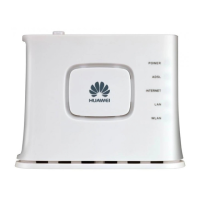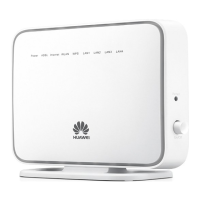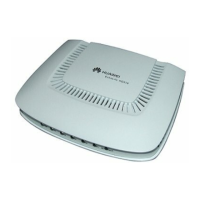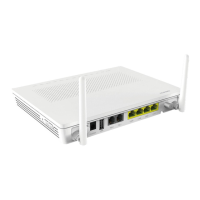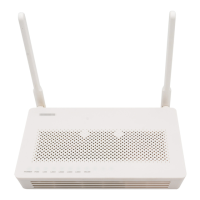Do you have a question about the Huawei EchoLife HG520s and is the answer not in the manual?
Key safety guidelines for device installation and operation.
Conditions for safe device placement, ventilation, and protection from environmental factors.
Instructions for safely cleaning the device using a soft cloth.
Details the capabilities and performance characteristics of the HG520s home gateway.
Describes the physical appearance and internal structure of the HG520s.
Explains the indicators located on the front panel of the HG520s and their status meanings.
Details the interfaces and buttons found on the rear panel of the HG520s.
Explains the role of an external splitter in separating voice and data signals on the telephone line.
Steps to prepare your computer and HG520s before installation.
Guides the user through physically connecting the HG520s to the network and power.
Details the default parameters required for setting up the HG520s configuration environment.
Step-by-step instructions for establishing the initial configuration environment for the HG520s.
Describes the layout and components of the HG520s web configuration interface.
Introduces the general method for configuring the HG520s services.
Illustrates the protocol model for connecting the HG520s and DSLAM.
Outlines the general steps to realize various service modes on the HG520s.
Lists and describes the different service modes supported by the HG520s.
Details the necessary configurations for setting up the HG520s in bridge mode.
Provides step-by-step instructions for configuring the HG520s and computer for bridge mode.
Lists the configuration parameters required for PPPoE mode setup.
Guides through the configuration steps for PPPoE mode on the HG520s and computer.
Explains how to configure the HG520s for PPPoA mode, referencing PPPoE setup.
Outlines the preparation steps and parameters for RFC2684B mode configuration.
Provides step-by-step instructions for configuring RFC2684B mode on the HG520s.
Describes the configuration process for RFC2684 (IPoA) mode, similar to RFC2684B.
Details the configuration parameters needed for setting up the wireless mode.
Step-by-step guide for configuring the HG520s wireless settings and security.
General preparation steps for accessing advanced configuration options on the HG520s.
Instructions for configuring the Routing Information Protocol (RIP) for network routing.
Details how to configure internet security features and firewall settings on the HG520s.
Explains how to set up filters for IP addresses, masks, and ports to control network access.
Guides on configuring Quality of Service (QoS) to manage network traffic and prioritize applications.
Describes how to map WAN ports to LAN ports for network access and service availability.
Instructions for setting the device's timezone and synchronizing the system clock with a time server.
Details on configuring Access Control Lists (ACL) to manage network access based on IP addresses.
Explains how to enable Universal Plug and Play (UPnP) for device discovery and configuration.
Step-by-step guide to modify the HG520s's local area network IP address.
Procedure for changing the administrator password to enhance security and access control.
Instructions on how to reset the HG520s to its original factory default settings.
Guide on how to update the HG520s firmware to the latest version.
Provides common problems and their solutions for troubleshooting the HG520s.
Frequently Asked Questions and their answers to assist users with common issues.
Details ADSL standards, data transfer rates, and physical features of the HG520s.
Lists common default parameters and default PVC parameters for the HG520s.
Provides default values for administrator credentials, IP, subnet mask, DHCP, and NAT.
Lists default Permanent Virtual Channel (PVC) settings including mode, VPI, and VCI.
Glossary of common abbreviations used in the HG520s user manual.
Key safety guidelines for device installation and operation.
Conditions for safe device placement, ventilation, and protection from environmental factors.
Instructions for safely cleaning the device using a soft cloth.
Details the capabilities and performance characteristics of the HG520s home gateway.
Describes the physical appearance and internal structure of the HG520s.
Explains the indicators located on the front panel of the HG520s and their status meanings.
Details the interfaces and buttons found on the rear panel of the HG520s.
Explains the role of an external splitter in separating voice and data signals on the telephone line.
Steps to prepare your computer and HG520s before installation.
Guides the user through physically connecting the HG520s to the network and power.
Details the default parameters required for setting up the HG520s configuration environment.
Step-by-step instructions for establishing the initial configuration environment for the HG520s.
Describes the layout and components of the HG520s web configuration interface.
Introduces the general method for configuring the HG520s services.
Illustrates the protocol model for connecting the HG520s and DSLAM.
Outlines the general steps to realize various service modes on the HG520s.
Lists and describes the different service modes supported by the HG520s.
Details the necessary configurations for setting up the HG520s in bridge mode.
Provides step-by-step instructions for configuring the HG520s and computer for bridge mode.
Lists the configuration parameters required for PPPoE mode setup.
Guides through the configuration steps for PPPoE mode on the HG520s and computer.
Explains how to configure the HG520s for PPPoA mode, referencing PPPoE setup.
Outlines the preparation steps and parameters for RFC2684B mode configuration.
Provides step-by-step instructions for configuring RFC2684B mode on the HG520s.
Describes the configuration process for RFC2684 (IPoA) mode, similar to RFC2684B.
Details the configuration parameters needed for setting up the wireless mode.
Step-by-step guide for configuring the HG520s wireless settings and security.
General preparation steps for accessing advanced configuration options on the HG520s.
Instructions for configuring the Routing Information Protocol (RIP) for network routing.
Details how to configure internet security features and firewall settings on the HG520s.
Explains how to set up filters for IP addresses, masks, and ports to control network access.
Guides on configuring Quality of Service (QoS) to manage network traffic and prioritize applications.
Describes how to map WAN ports to LAN ports for network access and service availability.
Instructions for setting the device's timezone and synchronizing the system clock with a time server.
Details on configuring Access Control Lists (ACL) to manage network access based on IP addresses.
Explains how to enable Universal Plug and Play (UPnP) for device discovery and configuration.
Step-by-step guide to modify the HG520s's local area network IP address.
Procedure for changing the administrator password to enhance security and access control.
Instructions on how to reset the HG520s to its original factory default settings.
Guide on how to update the HG520s firmware to the latest version.
Provides common problems and their solutions for troubleshooting the HG520s.
Frequently Asked Questions and their answers to assist users with common issues.
Details ADSL standards, data transfer rates, and physical features of the HG520s.
Lists common default parameters and default PVC parameters for the HG520s.
Provides default values for administrator credentials, IP, subnet mask, DHCP, and NAT.
Lists default Permanent Virtual Channel (PVC) settings including mode, VPI, and VCI.
Glossary of common abbreviations used in the HG520s user manual.
| Wireless Standard | IEEE 802.11b/g |
|---|---|
| Wireless Frequency | 2.4 GHz |
| Maximum Wireless Speed | 54 Mbps |
| Security | WEP, WPA, WPA2 |
| Power Supply | 12V DC, 1A |
| LAN Interface | 4 x 10/100 Mbps Ethernet Ports |
| ADSL Standards | ITU G.992.1 (G.dmt), ITU G.992.2 (G.lite), ITU G.992.3 (ADSL2), ITU G.992.5 (ADSL2+) |




